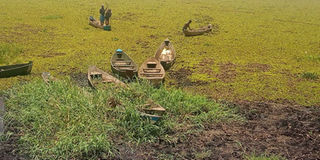New water weed threatens fishing industry - scientists

Hindrance. Fishermen struggle to peddle through the water weed that covered Lake Kyoga at Lugonyola Landing Site in Bukamba Sub-county, Kaliro District. PHOTO BY DENIS EDEMA
What you need to know:
- Effect. Scientists say the weed piles in fish breeding places and cuts off oxygen supply, which has left many young fish dead.
Kaliro. A new water weed believed to have devastating effects on water bodies is threatening the fishing industry.
The Kariba weed, locally known as Nankabirwa, has blocked parts of Kyoga Basin, Lake Albert and the Albert Nile as researchers contemplate on how it can be eliminated.
Scientists have named the weed Salvinia Molesta. The weed has invaded various landing sites in the districts of Kaliro, Buyende, and Pallisa, among others.
The weed piles in fish breeding places and cuts off oxygen supply, which has left many young fish dead, hence threatening the livelihood of thousands of people depending on fishing for a livelihood.
A senior aquatic research officer with the National Fisheries Resources Research Institute (NaFIRRI), Dr Fred Wanda, says they have embarked on research to control and eliminate the weed before it spreads to other water bodies.
He says they are to employ biological strategies, which involve the use of Salvinia weevils deployed on the lake to eat up the weed.
“Removing it manually will not clean the entire lake, use of machines and by hand, is only suitable for small infestations. Harvesting equipment also can encounter difficulties, it cannot access shallow areas. The chemical method also faces difficulty as the weed has some resistance to herbicides and spreading the entire lake has some consequences on the environment,’’ he says
Breeding rate
Dr Wanda says the weed multiplies at a high rate compared to the water hyacinth.
He warns fishermen on their movement with fishing gears across various water bodies as a temporary control measure for the spread of the weed.
“I advise fishermen not to move with their fishing gears because they will move with some small parts and it will be introduced on other lakes,’’ he says
Last week, the director of fisheries in the Ministry of Agriculture, Dr Edward Rukunya, said they asked government for Shs4 billion in their supplementary budget that is going to be used to fight the water weed.
Records from Bank of Uganda show that in the calendar year ending 2018, Uganda’s export earnings from fish were the highest the country has received in the last 20 years.
The country exported fish worth $171 million (Shs635 billion) the highest revenue the country has ever earned from this commodity. The records further indicate that the volumes in this calendar year were the highest at 24,545 metric tonnes in the last 10 years when the country exported 27,454 metric tonnes.
Fishermen speak
The chairperson of Lugonyola Landing Site in Bukamba Village, Nawampiti Sub-county in Kaliro District, Mr Ben Munyolo, on Wednesday said the weed forms dense-mat cover on water surface and affects the movement of fish, blocks boat access and the catching of fish.
“The devastating weed is hurting fishing as it destroys fishing nets and chokes fish. We cannot navigate many parts of the lake and we have abandoned the boats,’’ he said
Mr Munyolo added: “We have been accessing districts such as Buyende and Pallisa through sailing on water from Kaliro using only Shs3,000, but now it requires us to use between Shs30,000 and Shs40,000 on a commercial motorcycle because we do not have taxis in the area,’’ he said.
Mr Moses Sooma, a fisherman, said the weed has covered the lake for the last six months.
“Fishing is our economic activity in the area, but we are no longer working yet we have families to take care of.
“We lay the nets at night, but in the morning, we find no fish catch because the weed keeps entangling them, leaving us with no source of income,’’ he said.
Although Government had distributed manual control equipment such as wheel barrows, fork spades, forked hoes, hip waders, pangas, hand gloves, rakes, life jackets and gumboots to the affected areas, fishermen at some landing sites such as Lugonyola rejected them on grounds that it would not work out because they had tried it earlier.
Affected area in Lake Kyoga
The Kaliro District principal fisheries officer, Mr Fred Mbalumya, said the weed has covered 90 per cent of the total area of Lake Kyoga.
He said Kaliro was earning tax revenue of Shs80m annually but since the weed invaded the lake, less is being collected from the landing site.
“It has affected the income status of the fishermen and the district tax revenue collection, there is limited primary production of planktons and most fish cannot tolerate anoxic conditions, which affects the breeding process,’’ he said.
The experts have now call upon government to act and save the fishing sector.
Discovering the weed
Data at NaFIRRI indicates that Kariba weed was first seen on Uganda’s water bodies in June, 2013. The water weed is an aquatic, mat-forming, free-floating fern with horizontal stems up to 25cm long. Green to yellow-green oval leaves form in pairs with dense upper surface cover of hairs. Feathery, root-like leaves hang down in the water.
Researchers say, it was named Kariba weed because it was first noticed on the African Continent on Lake Kariba between Zambia and Zimbabwe.
In early 1990s, the thick carpets of hyacinth covered about 12,000 hectares [77 square miles] of Lake Victoria but it was successfully removed by a biological control method under a 20m dollar project dubbed, Uganda-Egypt Aquatic Weed Control.




